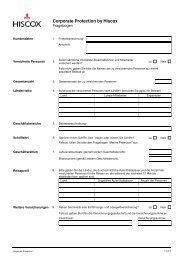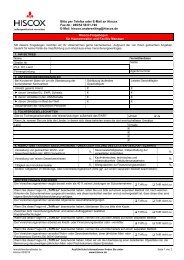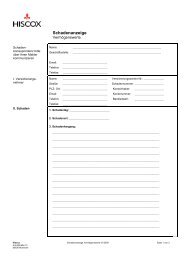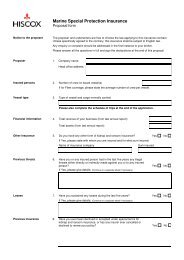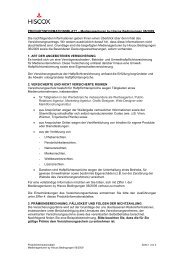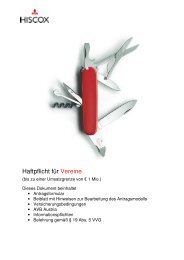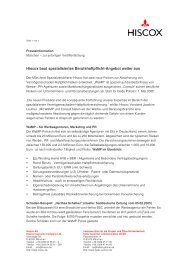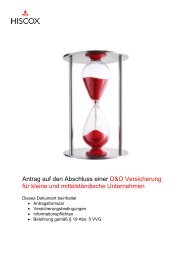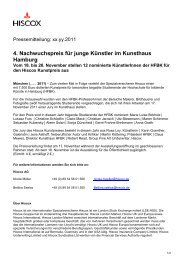Download PDF - Hiscox
Download PDF - Hiscox
Download PDF - Hiscox
You also want an ePaper? Increase the reach of your titles
YUMPU automatically turns print PDFs into web optimized ePapers that Google loves.
Notes to the consolidated<br />
financial statements<br />
continued<br />
2 Significant accounting policies continued<br />
2.22 Use of critical estimates,<br />
judgements and assumptions continued<br />
of risk beyond that envisaged at the time<br />
of original policy issuance. The Group seeks<br />
to gather corroborative evidence from all<br />
relevant sources before making judgements<br />
as to the eventual outcome of claims,<br />
particularly those under litigation, which have<br />
occurred and been notified to the Group but<br />
remain unsettled at the balance sheet date.<br />
Estimates of insurance liabilities are<br />
continually evaluated based on entity<br />
specific historical experience and<br />
contemporaneous developments observed<br />
in the wider industry when relevant, and<br />
are also updated for expectations of<br />
prospective future developments. Although<br />
the possibility exists for material changes<br />
in insurance liability estimates to have<br />
a critical impact on the Group’s reported<br />
performance and financial position, it is<br />
anticipated that the scale and diversity of<br />
the Group’s portfolio of insurance business<br />
considerably lessens the likelihood of this<br />
occurring. Note 27 to the consolidated<br />
financial statements provides a greater<br />
analysis of the main methods used by<br />
the Group when formulating estimates<br />
of the insurance claims liabilities at each<br />
balance sheet date.<br />
The Group carries its financial investments<br />
at fair value through profit or loss with<br />
fair value determined using published price<br />
quotations in the most active financial<br />
markets in which the assets trade.<br />
During periods of economic distress and<br />
diminished liquidity, the ability to obtain<br />
quoted bid prices may be reduced and<br />
as such a greater degree of judgement<br />
is required in obtaining the most reliable<br />
source of valuation. Note 3.2 to the financial<br />
statements discusses the reliability of the<br />
Group’s fair values.<br />
With regard to employee retirement benefit<br />
scheme obligations, the amounts disclosed<br />
in these consolidated financial statements<br />
are sensitive to judgemental assumptions<br />
regarding mortality, inflation, investment<br />
returns and interest rates on corporate<br />
bonds, many of which have been subject<br />
to specific recent volatility. This complex<br />
set of economic variables may be expected<br />
to influence the liability obligation element<br />
of the reported net balance amount to a<br />
greater extent than the reported value of<br />
the scheme assets element. For example,<br />
if the recent cuts in official UK interest rates<br />
are replicated with lower yields emerging<br />
in UK corporate bond indices, a significant<br />
uplift may occur in the reported net scheme<br />
deficit through the reduced effect of<br />
discounting outweighing any expected<br />
appreciation in asset values. A sensitivity<br />
analysis is given at note 31.<br />
Legislation concerning the determination<br />
of taxation assets and liabilities is complex<br />
and continually evolving. In preparing the<br />
Group’s financial statements, the Directors<br />
estimate taxation assets and liabilities after<br />
taking appropriate professional advice.<br />
The determination and finalisation of<br />
agreed taxation assets and liabilities<br />
may not occur until several years after<br />
the balance sheet date and consequently<br />
the final amounts payable or receivable<br />
may differ from those presently recorded<br />
in these financial statements.<br />
2.23 Reporting of additional<br />
performance measures<br />
The Directors consider that the claims<br />
ratio, expense ratio and combined ratio<br />
measures reported in respect of operating<br />
segments and the Group overall at note 4<br />
provide useful information regarding the<br />
underlying performance of the Group’s<br />
businesses. These measures are widely<br />
recognised by the insurance industry and<br />
are consistent with internal performance<br />
measures reviewed by senior management<br />
including the chief operating decision<br />
maker. However, these three measures are<br />
not defined within the IFRS framework and<br />
body of standards and interpretations and<br />
therefore may not be directly comparable<br />
with similarly titled additional performance<br />
measures reported by other companies.<br />
Net asset value per share and return on<br />
equity measures, disclosed at notes 5<br />
and 6, are likewise considered to be<br />
additional performance measures.<br />
3 Management of risk<br />
Overview of risk<br />
The Group enters into contracts that<br />
directly accept and transfer insurance risk,<br />
which in turn necessarily creates exposure<br />
to financial and other classes of risk.<br />
Consequently, <strong>Hiscox</strong> is fundamentally<br />
concerned with the identification and<br />
management of all significant risks.<br />
The Group’s overall appetite for accepting<br />
and managing varying classes of risk is<br />
defined by the Group’s Board. The Board<br />
has developed a governance framework<br />
and set Group-wide risk management<br />
policies and procedures which cover<br />
specific areas such as risk identification,<br />
risk management and mitigation, and risk<br />
60 Notes to the consolidated financial statements <strong>Hiscox</strong> Ltd Report and Accounts 2009<br />
reporting. The objective of these policies<br />
and procedures is to protect the Group’s<br />
shareholders, policyholders and other<br />
stakeholders from negative events that<br />
could hinder the Group’s delivery of its<br />
contractual obligations and its achievement<br />
of sustainable profitable economic and<br />
social performance.<br />
The Board exercises oversight of the<br />
development and operational implementation<br />
of its risk management policies and<br />
procedures, and ongoing compliance<br />
therewith, partially through its own enquiries<br />
but primarily through a dedicated internal<br />
audit function, which has operational<br />
independence, clear terms of reference<br />
influenced by the Board’s Non Executive<br />
Directors and a clear upwards reporting<br />
structure back into the Board.<br />
The main sources of risk relevant to the<br />
Group’s operations and its financial<br />
statements fall into two broad categories:<br />
insurance risk and financial risk. Note 3.1<br />
details the Group’s approach to managing<br />
insurance risk specifically whilst note 3.2<br />
onwards outlines the Group’s sensitivity to<br />
financial risk generally. Additional unaudited<br />
information is also provided in the corporate<br />
governance and risk management sections<br />
of this Report and Accounts.<br />
The Group, in common with the<br />
non-life insurance industry generally,<br />
is fundamentally driven by a desire to<br />
originate, retain and service insurance<br />
contracts to maturity, rather than engaging<br />
in mass distribution of the risks assumed<br />
through large scale securitisation. The<br />
Group’s business is therefore fundamentally<br />
different from other types of financial<br />
institutions in that its cash flows are<br />
funded mainly through advance premium<br />
collections rather than assuming cash<br />
deposits, and the timing of such premium<br />
inflows is reasonably predictable. In<br />
addition, the majority of material cash<br />
outflows are typically triggered by the<br />
occurrence of insured events noncorrelated<br />
to financial markets, and not<br />
by the inclination or will of policyholders.<br />
Consequently, as the Group therefore has<br />
the capacity to invest and hold a significant<br />
proportion of assets to maturity if required,<br />
it has the ability for many of its ultimate<br />
cash flows to remain relatively immune to<br />
short-term, technically driven accounting<br />
losses in fair value terms.<br />
3.1 Insurance risk<br />
Insurance risk is transferred to the Group<br />
by contract holders through the underwriting<br />
process. The Group’s exposure to<br />
insurance risk arises from the possibility




